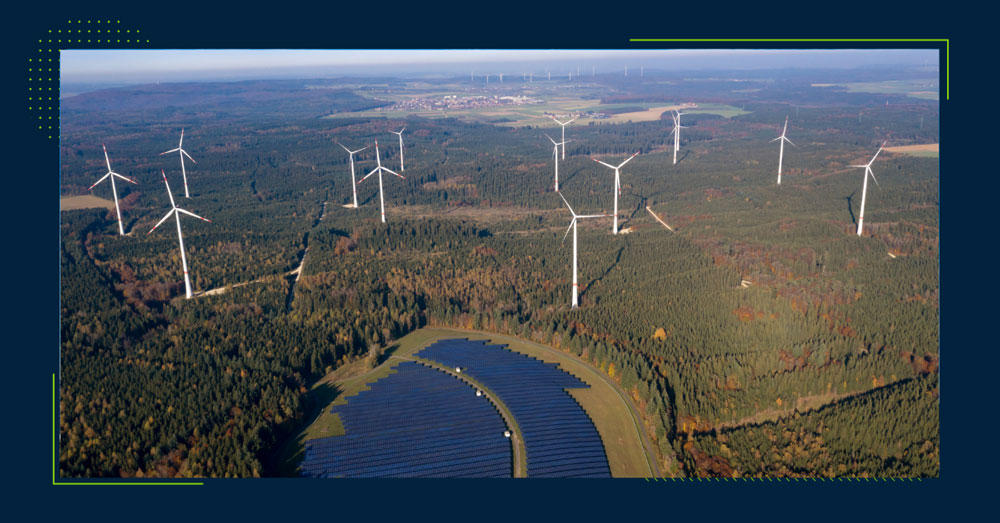Solar and wind PPAs are popular tools that let energy consumers (commonly called “offtakers”) take advantage of clean, renewable power without needing to own solar panels or wind turbines themselves. This is where PPAs come into play — you get the power without the asset!
You get the power without the asset.
These agreements are incredibly flexible and pull together an individual energy offtaker (take Amazon, for example, as they frequently use PPAs) and a renewable energy developer under one highly complex (but soon-to-be simplified) arrangement. In recent years, growth in clean energy power purchase agreements has been truly remarkable, particularly in the corporate sector. According to BloombergNEF, corporate clean energy buying rose 18% throughout 2020, despite COVID-19 turbulence in traditional energy markets. Whereas fossil fuels struggled amid a collapse in demand, green energy did phenomenally well. Solar and wind PPAs certainly contributed to this!
We know that PPAs are super popular, but what individual parts make the whole thing work? By this, we simply mean, what do these agreements look like? What kind of sections do they feature? While the specifics of each PPA will inevitably vary based on precise conditions, several components are guaranteed to be included, which we cover below.
It’s essential to keep in mind that the following list of PPA sections is not at all exhaustive — it’s simply intended to offer an easy-to-digest overview of what solar and wind PPAs are composed of. Actual PPA documents are far longer and are rife with legalese (jargon that requires a law degree to understand — seriously)
Introduction, Terms and Definitions
Here you have a basic introduction to the PPA at hand, which outlines the parties involved in the clean energy transaction — a solar or wind energy project owner and the energy offtaker (let’s stick with our earlier example of Amazon just to keep things easy).
Additionally, the time period in which the agreement will take place is laid out here. This is usually separated into an initial period (when the PPA takes effect, aka is signed) and an operational period, which begins when the electricity supply begins.
An extension clause is also typically included here to describe what will happen when the PPA contract ends. And having a built-in process to address important future decisions such as an extension clause definitely helps quash last-minute anxiety and stress! And the more flushed out an agreement is, the clearer future actions become.
Access Rights
While it may sound obvious, a solar PPA or a wind PPA still has to outline who has access to the renewable energy equipment for construction, maintenance and upkeep reasons. Contractors and other parties also need reliable access to water, storage, communication and transmission services, and electricity — all of which has to be spelled out in the PPA contract to ensure smooth delivery.
Solar and wind PPAs, then, can be thought of as documents that are designed to sniff out potential future problems and do away with them before they get the chance to compromise clean energy projects.
Planning, Installation, and Operation of a Project
This section specifies instructions for on-site assessments and the early-stage planning of a project, along with an expected “start by” construction date. Additionally, it outlines the kind of contractors that will be used in the project and the required steps needed for the project to be halted. Most of the burden of power purchase agreements falls on the renewable energy developer, rather than the energy offtaker.
Payment and Billing
In the PPA payment and billing section, purchased energy is given an established price — or schedule to be technical. Additionally, this section will outline whatever specific payment agreement has been decided upon, such as the frequency and particular details of invoice delivery.
Most solar PPAs and wind PPAs feature monthly billing cycles with invoices that include the quantity of electricity purchased during a time period, the applicable rate, and the total amount due. There are plenty of different ways to get paid for generating power, with the math difficulty ranging from quite simple to highly complex — especially when factoring in indices, penalties, curtailments, hedges, etc.
This section also includes a part on disputed invoices — how to handle them, the grounds for objection, and the time frame for addressing them. These contracts effectively impose a statute of limitations, which is a fancy way of saying invoice-related disputes have an expiry date. So, an energy offtaker such as Amazon would be unlikely to challenge an invoice paid three years prior. However, if it was just a few weeks, the story would likely be different.
End of Term
Once a power purchase agreement’s term limits are met (the contract has played its course), firms must decide what to do with the solar or wind asset. End-of-term sections in PPA agreements outline the terms and conditions available to transfer asset ownership (solar or wind equipment) to the energy offtaker according to fair market prices.
Suppose an energy offtaker like Amazon wanted to purchase an end-of-term PPA solar array or wind farm for a discounted price (since the asset would have deteriorated considerably throughout the contract). In that case, the asset’s ownership would be transferred, along with responsibilities and liabilities.
The decommissioning process is also included in the end-of-term section. Usually, the PPA contract will outline specific measures (i.e., taking all reasonable precautions to avoid economic damage during decommissioning) designed to make the process less disruptive. This is particularly true for solar energy power purchase agreements, which are commonly located on-site, requiring extra caution to avoid disrupting the offtakers regular operations.
Tax and Insurance
The PPA agreement will specify which party is responsible for paying various income, sales, and property taxes, along with a process and deadline for delinquent tax reimbursement. It’s pretty standard, for example, that if one of the parties in a PPA fails to pay taxes that could result in harm, the other party can cover the charge with a guarantee of future reimbursement. All this means is that there’s no shortchanging your PPA partner!
Both a renewable energy owner and offtaker require insurance; these policies will be outlined here as well along with insurance certificates (which act as proof of purchase).
Warranties
Warranties are a standard in the solar and wind industry and are required to ensure a seamless, uninterrupted service experience. The specifics in question here depend on the renewable energy supplier’s company policies, the equipment in use, and the duration of the power purchase agreement. The course of most PPAs tends to range from 10 to 25 years (1).
Limitations on Damages and Dispute Resolutions
Power purchase agreements commonly limit the extent of damages each party can potentially be liable for. In layman’s terms, this means signatories of a PPA are somewhat protected from being sued. This represents a built-in safety feature for solar and wind producers as it helps effectively distributes risks and damages.
Dispute resolutions are the final piece we’ll look at today. They typically exist as a series of progressing instructions. For example, suppose Amazon had a dispute with one of its PPA providers. In that case, a voluntary negotiation period may begin first, followed by non-binding mediation.
If these two procedures were still unsuccessful in producing an outcome both parties find agreeable, the next step could be legally-binding arbitration. Of course, this is just one potential example of how disputes might be handled.
Though they’re time-consuming to produce, and seem to be made up of a never-ending supply of sections, solar PPAs and wind PPAs make clean energy even more appealing and accessible. This is quite the feat now that renewables are the cheapest sources of energy on the market!
Every solar PPA and wind PPA features special provisions, though as we mentioned in our last blog post, “All About Power Purchase Agreements,” there is a growing trend towards simple, standardized PPA templates. The sections described above represent the basic structure of a solar or wind PPA — and we mean really basic. PPA documents, after all, are complicated and consist of hundreds of individual clauses.
So, while we’ve offered simple explanations here, it’s essential to keep in mind that the devil’s in the details with power purchase agreements. So read them carefully.




